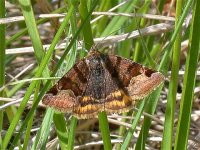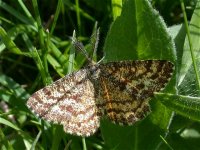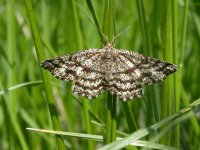-
Welcome to BirdForum, the internet's largest birding community with thousands of members from all over the world. The forums are dedicated to wild birds, birding, binoculars and equipment and all that goes with it.
Please register for an account to take part in the discussions in the forum, post your pictures in the gallery and more.
You are using an out of date browser. It may not display this or other websites correctly.
You should upgrade or use an alternative browser.
You should upgrade or use an alternative browser.
National moth night (UK) (1 Viewer)
- Thread starter Surreybirder
- Start date
More options
Who Replied?harry eales
Ancient Entomologist
CJW said:I agree with Harry on this, now that we have seen the underside of the underwing (I would have preferred the underside of the upperwing for completeness), that cross line just seems a little too 'smooth' for Dark Marbled.
One of my reasons for going for Common rather than Dark Marbled Carpet was the ochre/yellow patch on the central area of the forewing. I cannot say I have ever seen this colour on Dark Marbled Carpet, at least locally, nor can I recollect it being shown in any pictures of Dark Marbled Carpet. I would agree that they can be very difficult to separate at times.
Harry Eales.
I got a total of 18 species in 4 traps, I would still have been disappointed even if I had 50 species. Its all relative, but on a good mothing night end of May, I think at least 60-70species would be an expected return from 4 traps in different habitats considering that last week I was getting 50+ from one habitat. Still it was better than last year!! 8 moths in 4 traps.
Swift said:Angus T ,the moth debate raged between Dogs Tooth, Pale Shouldered and Beautifull Brocade , the general opionion was that it could well be a Beautifull Brocade in our county there is only one record and that is of a possible! I am new to the moth game but I could see the points thay pointed out ,I think they intend to show it "Mr Big" today so will post when I find out what the decision is , cheers.
Certainly Angle shades is never one involved in an ID debate. I thought it was one of your moths from your garden trap, and mentioned what first came into my head. It has been known that the "first came into my head" answer has been correct, though I can't remember when
CJW
Hit-and-run WUM
Angus T said:It has been known that the "first came into my head" answer has been correct, though I can't remember when
Here:
http://www.birdforum.net/showthread.php?t=17152
Brian Stone
A Stone chatting
Had a pretty thin time of it. Went to the Northants meeting at Collyweston Deeps (a limestone grassland site) where a party of a dozen or so die-hards shivered through a couple of hours and half a dozen species (including Green Carpet (the only numerous moth and still not very many), Treble Lines, Common Heath and The Lychnis).
The garden trap was empty on returning late in the night so, with the temperature near freezing, I turned the thing off. The actinic left at my lightly wooded riverine local nature reserve was little better this morning: one smart male Muslin Moth and a Turnip Moth.
Had a much better time out in the daytime today. Couldn't find Mother Shipton but Burnet Companion, Common Heath and Latticed Heath all posed for photos at another limestone site: Barnack Hills and Holes. Also nice Brown Argus, Common Blue and Green Hairstreak butterflies.
The garden trap was empty on returning late in the night so, with the temperature near freezing, I turned the thing off. The actinic left at my lightly wooded riverine local nature reserve was little better this morning: one smart male Muslin Moth and a Turnip Moth.
Had a much better time out in the daytime today. Couldn't find Mother Shipton but Burnet Companion, Common Heath and Latticed Heath all posed for photos at another limestone site: Barnack Hills and Holes. Also nice Brown Argus, Common Blue and Green Hairstreak butterflies.
Attachments
Last edited:
harry eales
Ancient Entomologist
Angus T said:Well done in getting photos. Never seen Common heath, nor Burnet Companion, though did see Mother Shipton yesterday, and one in my garden today. Absolutley no chance of getting photo of it.
I also get Burnet Companion and Mother Shipton although just occasional specimens. However, Common Heath abound on the bogs and mires in Northumberland, not in dozens or even hundreds but literally in thousands. They're a positive menace in late May and throughout June on all my Large Heath butterfly sites in this county and also on nearly every Heather moor.
Try a peat bog Angus you should see plenty of them.
Harry Eales.
harry eales said:They're a positive menace in late May and throughout June on all my Large Heath butterfly sites in this county and also on nearly every Heather moor.
Try a peat bog Angus you should see plenty of them.
Harry Eales.
Sounds a bit like LYU syndrome
I don't venture much from farm though is bog within 10 miles, so I'm sure I'll see it in years to come.
Brian Stone
A Stone chatting
brianhstone said:Burnet Companion, Common Heath and Latticed Heath all posed for photos ...
Just been pulled up on my Id of Latticed Heath. I was going on the strength and definition of the dark bands and the uneven outer edge of the hindwing but it seems to lack the dark veins of Latticed so I think it must be a well marked female Common Heath. Oops!
brianhstone said:Just been pulled up on my Id of Latticed Heath. I was going on the strength and definition of the dark bands and the uneven outer edge of the hindwing but it seems to lack the dark veins of Latticed so I think it must be a well marked female Common Heath. Oops!
I didn't check what you'd called them, I just assumed it was either 2 views of one moth or 2 different Common Heath. And I was wondering why you hadn't put up picture of Latticed Heath, as I think there is a form in Ireland that differs a little. I've only recorded 2 or 3 and am still undecided what form I get here.
Last edited:
Surreybirder
Ken Noble
As I've finally just bought Skinner I thought I'd compare it with Waring, to see which was most use on common vs latticed heath. Both give the two as 'confusion species' but only Waring specifically mentions the lack of dark veins in Common heath. Though both books show this feature in their illustrations.
I guess that, as with bird ID books, it's probably quite a help to have more than one.
I guess that, as with bird ID books, it's probably quite a help to have more than one.
harry eales
Ancient Entomologist
Surreybirder said:As I've finally just bought Skinner I thought I'd compare it with Waring, to see which was most use on common vs latticed heath. Both give the two as 'confusion species' but only Waring specifically mentions the lack of dark veins in Common heath. Though both books show this feature in their illustrations.
I guess that, as with bird ID books, it's probably quite a help to have more than one.
Cor, stone the bleedin' Crows, mate.
I never had this identification problem using Newmans "Illustrated Natural History of British Butterflies and Moths" 1869, and these were illustrated by black and white woodcuts. Similarly, no problems with South's Moths either. It's only in the modern books where confusion arises in identifying these species.
The habitat gives the main clue as to the species. Common Heath is generally a heath or moorland species, whereas Latticed Heath is generally a grassland species.
Copies of Newman's book are worth having and they're quite cheap secondhand, you can get a copy for under £30 at any good secondhand book dealer.
Harry Eales.
(Ancient entomologist)
Surreybirder
Ken Noble
You're forgetting what a novice I am, Harry. My 'life list' is still only about 50 species. I'm at what would be the birding equivalent of trying to decide between a ringed and a little ringed plover!
harry eales
Ancient Entomologist
Surreybirder said:You're forgetting what a novice I am, Harry. My 'life list' is still only about 50 species. I'm at what would be the birding equivalent of trying to decide between a ringed and a little ringed plover!
Novice or not, your life list includes about 25 species I have never seen alive here, 'up north'. lol. I would sell my soul* for the opportunity of seeing Lime Hawk or Great Prominent in my garden trap.
I have to admit I'm not a 'birder' although I can identify a great many species, they're just not as interesting as butterflies and moths. Even when I saw a pair of breeding Bee Eaters in local Quarry a couple of years ago, I was more interested in the Northern Brown Argus butterflies present.
* I think the last 'Soul' for sale on E-Bay went for £15.00. lol.
Harry Eales.
Surreybirder
Ken Noble
It's still about 16 deg C here at the moment, so I hope to get one or two more tonight!
Don't sell your soul, Harry, come and visit the deep south. It's not that bad!
Don't sell your soul, Harry, come and visit the deep south. It's not that bad!
harry eales
Ancient Entomologist
Surreybirder said:It's still about 16 deg C here at the moment, so I hope to get one or two more tonight!
Don't sell your soul, Harry, come and visit the deep south. It's not that bad!
Hi Ken,
There is only one reason I would ever voluntarily visit the south of England and that is to visit the British Museum, Dept of Entomology. I was stationed in the south during my days in the RAF. I last visited London in 1977 and even then I was only passing through.
Thanks for the offer, but I'll stick to the North East, there are less people per sq mile here than anywhere else in the U/K. I like my peace and quiet.
Harry Eales.
The solitary entomologist.
Brian Stone
A Stone chatting
harry eales said:The habitat gives the main clue as to the species. Common Heath is generally a heath or moorland species, whereas Latticed Heath is generally a grassland species.
Well the photos were taken on a limestone grassland site famed for flowers such as Pasque flower and Man Orchid among many others.
http://www.english-nature.org.uk/special/nnr/nnr_details.asp?NNR_ID=12
Just guessing, but, with Common Heath being a very widespread species, I think the lack of heathland around here means they are common on such sites and the habitat distinction is less significant.
Users who are viewing this thread
Total: 2 (members: 0, guests: 2)






